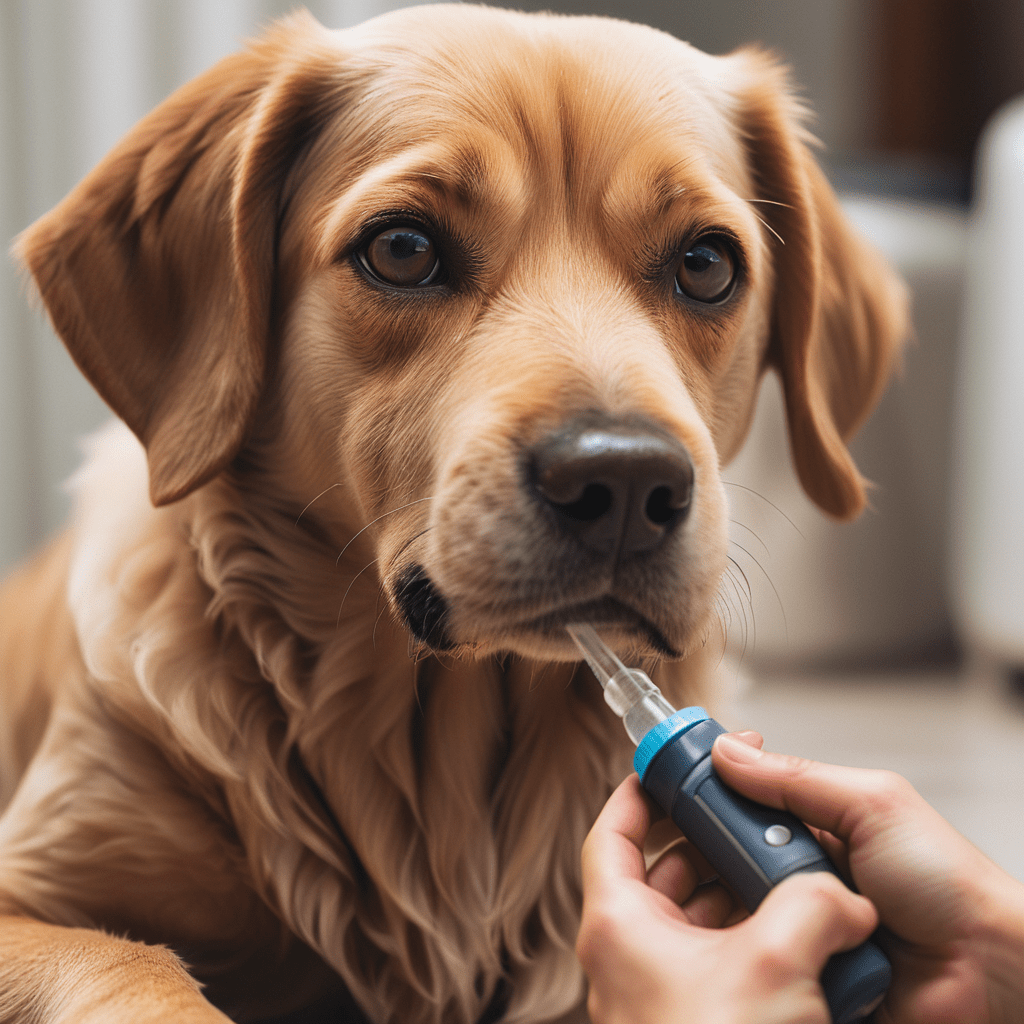how to tell if dog has fever without thermometer Many dog owners believe that detecting a fever in their furry companions without a thermometer is nearly impossible. However, with keen observation and knowledge of subtle cues, identifying potential signs of fever in dogs can be easier than you think.
In this comprehensive guide, we will delve into the world of canine health and discuss seven surefire ways to recognize if your dog has a fever without relying on a thermometer.
Understanding Dog Fever
Before we jump into the methods of identifying fever in dogs, it’s crucial to understand what fever means for our canine friends.
A fever in dogs, also known as pyrexia, is a temporary increase in body temperature often caused by an underlying health issue. Common causes of fever in dogs include infections, inflammatory conditions, and even stress or anxiety.
Signs and Symptoms of Dog Fever
Lethargy and Reduced Activity
One of the first signs that your dog may be running a fever is a noticeable decrease in energy levels. If your usually active pup seems unusually lethargic or uninterested in playtime, it could be a red flag.
Loss of Appetite
Dogs are notorious for their love of food, so a sudden loss of appetite can be a clear indicator that something isn’t right. Keep an eye on your dog’s eating habits and note any significant changes.
Unusual Panting
While panting is a normal way for dogs to regulate their body temperature, excessive or unusual panting can signal discomfort or fever.
Warm Ears and Nose
Feel your dog’s ears and nose. If they feel warmer than usual, it could indicate an elevated body temperature.
Behavioral Changes
Pay attention to any changes in your dog’s behavior, such as restlessness, irritability, or seeking out cool areas in the house.
Dry Nose and Gums
A dog’s nose and gums are often moist. If they appear dry or sticky, it may be a sign of fever or dehydration.
Shivering or Trembling
In some cases, dogs with fever may experience shivering or trembling, especially if they are trying to generate heat to combat the fever.

Methods to Detect Dog Fever Without a Thermometer
Now that we’ve discussed the signs and symptoms of dog fever, let’s dive into the practical methods you can use to detect if your dog has a fever without relying on a thermometer.
Touch Test
One of the simplest ways to gauge your dog’s body temperature is by using your own touch. Place your hand on your dog’s skin, particularly around the abdomen or under the armpits. If the skin feels unusually warm to the touch, it could indicate a fever.
Observing Behavior
Pay close attention to your dog’s behavior. If they are unusually restless, pacing, or seeking out cool spots in the house, it could be a sign of discomfort due to a fever.
Checking Nose and Ears
While not always a definitive indicator, feeling your dog’s nose and ears can provide some clues. A warm and dry nose or ears that feel hotter than usual may suggest an elevated body temperature.
Monitoring Appetite and Water Intake
Keep track of your dog’s food and water intake. A decrease in appetite or increased thirst without a corresponding increase in activity could be a sign of illness, including fever.
Assessing Activity Levels
If your dog is less active than usual and shows a lack of interest in walks, playtime, or social interaction, it may warrant further investigation for potential fever.
Checking for Other Symptoms
Along with the above methods, be on the lookout for other symptoms such as vomiting, diarrhea, coughing, or difficulty breathing. These can sometimes accompany fever and provide additional clues.

Behavioral Changes
Dogs with fever may exhibit changes in behavior such as lethargy, irritability, or seeking comfort in unusual ways. Note any deviations from your dog’s normal behavior patterns.
By combining these methods and staying attuned to your dog’s overall well-being, you can take proactive steps to detect and address fever-related concerns even without a thermometer.
Home Remedies and Tips for Managing Dog Fever
When your dog is experiencing a fever, it can be a worrying time for pet owners. While veterinary care is crucial in many cases, there are also several home remedies and tips you can use to help manage your dog’s fever and provide them with comfort during this period.
Cool Compresses
Applying cool, damp towels or cloths to your dog’s body can help lower their body temperature and provide relief from fever discomfort. Focus on areas with high blood flow, such as the armpits, groin, and paw pads. Avoid using ice packs directly on your dog’s skin, as this can cause skin damage.
Hydration
Ensure that your dog stays well-hydrated during a fever episode. Encourage them to drink water regularly and consider offering electrolyte-rich fluids like diluted chicken broth to replenish lost nutrients. You can also add ice cubes to their water bowl to make it more appealing and refreshing.
Rest and Comfort
Create a comfortable and quiet environment for your dog to rest and recover. Provide a cozy bed or blanket in a cool area of the house away from direct sunlight or drafts. Limit their activity and encourage restful activities such as gentle walks or indoor play to avoid overexertion.
Monitor Temperature
While you may not have a thermometer, you can still monitor your dog’s temperature by observing their body cues. If they continue to exhibit signs of fever such as warm ears, panting, or lethargy despite your efforts, it may be time to seek veterinary care.
Your vet can perform a thorough examination and recommend appropriate treatment based on their findings.
Nutritious Diet
Offer easily digestible and nutritious meals to support your dog’s immune system during a fever. Opt for bland foods like boiled chicken and rice that are gentle on the stomach. Avoid feeding rich or fatty foods that can exacerbate digestive issues.
Herbal Remedies
Certain herbs like ginger or chamomile may have soothing properties that can help alleviate fever symptoms in dogs. Consult with a holistic veterinarian or herbalist for safe herbal options and appropriate dosages. Always ensure that any herbal remedies you use are pet-safe and free from harmful additives.
Medication
In some cases, your veterinarian may prescribe medication to help reduce your dog’s fever or manage underlying symptoms. Follow your vet’s instructions carefully regarding dosage and administration of any prescribed medications. Do not give your dog over-the-
counter human medications without consulting your vet, as these can be harmful or ineffective for dogs.
Comforting Environment

Provide your dog with comfort items such as a favorite toy, soft blanket, or comforting scents like lavender or chamomile. These can help reduce stress and promote relaxation during a fever episode.
When to Seek Veterinary Care for Dog Fever
While home remedies and proactive monitoring can be beneficial, there are instances where professional veterinary care is necessary for dogs with fever. Understanding when to seek veterinary attention is crucial for ensuring your dog receives the appropriate diagnosis and treatment.
Persistent Fever
If your dog’s fever persists for more than 24-48 hours despite your efforts to manage it at home, it’s time to consult your veterinarian. A prolonged fever could indicate an underlying infection, autoimmune disorder, or other health issue that requires medical intervention.
Your vet will conduct a thorough examination, possibly including blood tests or imaging studies, to identify the root cause of the fever and prescribe appropriate treatment.
Severe Symptoms
Dogs with fever may exhibit severe symptoms that warrant immediate veterinary attention. These symptoms can include difficulty breathing, rapid heartbeat, seizures, or loss of consciousness. If your dog shows any of these signs, do not delay—seek emergency veterinary care right away.
These symptoms can indicate a serious health emergency such as heatstroke, organ failure, or a severe infection that requires prompt medical intervention.
Lethargy and Weakness
While some lethargy is expected during a fever episode, excessive lethargy, weakness, or difficulty standing or walking can indicate a more significant health issue.
If your dog seems unusually weak or unable to move normally, consult your vet for evaluation. They will assess your dog’s overall condition, conduct neurological exams if necessary, and recommend appropriate treatment options.
Loss of Appetite and Dehydration
Persistent loss of appetite coupled with signs of dehydration such as sunken eyes, dry gums, and excessive thirst may indicate a more severe underlying health issue. Dogs with fever can become dehydrated quickly, especially if they are not eating or drinking adequately.
Your vet may recommend fluid therapy, supportive care, and further diagnostic tests to determine the cause of these symptoms and provide targeted treatment.
Behavioral Changes
Sudden and significant changes in your dog’s behavior, such as confusion, disorientation, aggression, or unusual vocalizations, can be concerning and should prompt a visit to the vet for evaluation. These behavioral changes can result from neurological issues, pain, or underlying medical conditions that require medical attention.
Your vet will assess your dog’s behavior, perform necessary tests, and develop a treatment plan tailored to your dog’s needs.

Underlying Health Conditions
If your dog has pre-existing health conditions such as diabetes, heart disease, kidney disease, or a weakened immune system, a fever can be particularly concerning and may indicate a flare-up or complication related to the underlying condition.
It’s essential to inform your vet about your dog’s medical history, as they may need to adjust treatment or consider additional factors when managing fever in these cases.
Recent Injuries or Surgeries
Dogs recovering from recent injuries or surgeries may be more susceptible to complications from fever, especially if they are also experiencing pain or inflammation. Monitor your dog closely for signs of fever, infection, or surgical complications such as redness, swelling, or discharge at the surgical site.
If you notice any concerning symptoms or changes in your dog’s condition, contact your vet promptly for evaluation and guidance.
conclusion
understanding how to identify and manage dog fever without a thermometer is a crucial skill for pet owners. By being attentive to your dog’s behavior, physical cues, and overall well-being, you can take proactive measures to ensure their health and well-being during fever episodes.
Throughout this comprehensive guide, we’ve explored the signs and symptoms of dog fever, practical methods for detecting fever without a thermometer, home remedies for managing fever at home, and the importance of seeking veterinary care when necessary.
Let’s delve deeper into the key takeaways from each section to reinforce your understanding and empower you to care for your dog effectively.
Signs and Symptoms Awareness
Recognizing the signs and symptoms of dog fever, such as lethargy, loss of appetite, warm ears, and unusual panting, is the first step in early detection. By staying vigilant and observant, you can identify potential fever episodes before they escalate.
Practical Methods for Detection
The touch test, observing behavior, checking nose and ears, monitoring appetite and water intake, assessing activity levels, and noting other symptoms are practical methods for detecting fever without a thermometer. These methods, when used together, provide a comprehensive picture of your dog’s health status.
Home Remedies and Tips
Cool compresses, hydration, rest and comfort, temperature monitoring, nutritious diet, herbal remedies (under veterinary guidance), and creating a comforting environment are effective home remedies and tips for managing dog fever. These measures can help alleviate discomfort and support your dog’s recovery.
When to Seek Veterinary Care
Knowing when to seek veterinary care is critical. Persistent fever, severe symptoms (e.g., difficulty breathing, rapid heartbeat), lethargy and weakness, loss of appetite and dehydration, behavioral changes,
underlying health conditions, recent injuries or surgeries—all these scenarios warrant prompt veterinary evaluation and treatment.
By combining these insights and taking a proactive approach to your dog’s health, you can create a nurturing environment that promotes well-being and swift recovery during fever episodes.
Remember, your veterinarian is your ally in providing the best care for your dog, so don’t hesitate to reach out for professional guidance and support.












